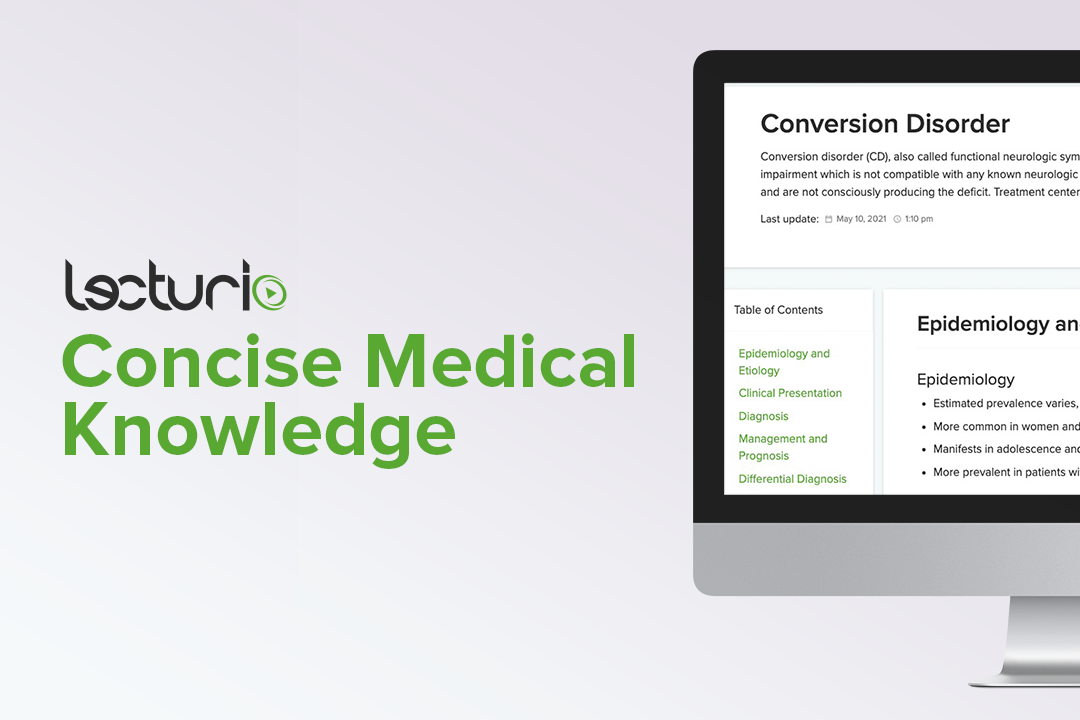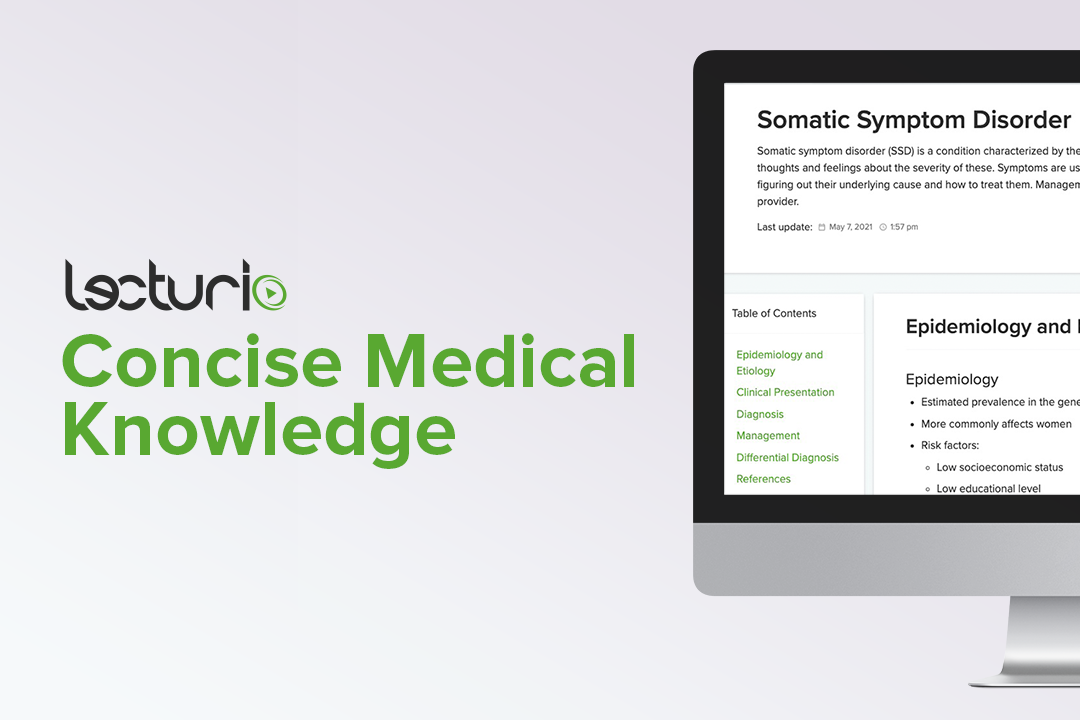Playlist
Show Playlist
Hide Playlist
Somatic Symptom and Other Disorders
-
Slides SomatoformOtherDisorders Psychiatry.pdf
-
Download Lecture Overview
00:00 Let’s take a closer look now at the Somatic Symptom and Other Disorders as they’ve been newly classified in the DSM-5. So somatic symptom disorder diagnosis, you are looking for the following diagnostic criteria. One or more symptomatic symptoms that cause distress or psychological impairment. Also excessive thoughts, feelings, or behaviors associated with the somatic symptoms demonstrated by one or more of these. Either persistent thoughts about the seriousness of symptoms, persistent severe anxiety about the symptoms or one’s general health, the time and energy devoted to the symptoms or health concerns is excessive and although the specific somatic symptoms may change, the disorder is persistent for more than a 6-month period. Illness anxiety disorder diagnosis is as follows: A preoccupation with having or acquiring a serious undiagnosed illness. Somatic symptoms are mild or non-existent. There is substantial anxiety about one's health and it’s either excessive behaviors related to health or maladaptive avoidance of situations or activities that are thought to represent health threats. The illness preoccupation is present for at least 6 months and the illness preoccupation is not better explained by another mental disorder or a general medical condition. So let’s consider this case example. “An elderly man comes to his primary care office complaining of anxiety due to motor problems. Numbness and tingling in his extremities and nausea over the past few months.” What do you think of his diagnosis? Actually, a key here is that this man is elderly so in the case of older individuals somatic symptoms are actually going to be most likely due to an organic cause or an actual medical problem. So you want to be careful not to just attribute something to a psychiatric reason, always keep that in mind, you always have to rule out general medical conditions. Conversion disorder and other psychiatric etiology should always be the last thing on your mind when it comes to your patients. Let’s talk a little bit now about conversion disorder, though conversion involves the presence of symptoms or deficits that affect voluntary motor or sensory function in a fashion that suggests a neurological condition but which is not explained by any medical findings. So the patient will have at least 1 neurological symptom either sensory or motor and it cannot be explained by a medical disorder. They may not be able to connect if the onset of the disorder might be preceded or exacerbated by some kind of a psychological stressor and it’s often a fact that the patient is surprisingly calm or even indifferent about their symptoms. We call this la belle indifference. When describing their symptoms, they just show very little regard and seem a little bit aloof to what’s happening even when it’s a serous symptom like blindness or paralysis. Check out this case study. “A 30-year-old woman visits her doctor complaining of blindness 1 week after she walked in on her husband having an affair. There are no abnormalities on her exam and a neurology and ophthalmology work-up is negative. So here you may be suspecting a conversion disorder. Right? She saw something she didn’t want to see, it’s a major psychological stress and all of a sudden she’s complaining of blindness. In the 1900s, who first described conversion disorder? Well, that’s Jean Martin Charcot. He taught in Paris and he really linked conversion symptoms to trauma. Later, Sigmund Freud looked at the importance of the unconscious process and his analysis of patients and he wrote about the famous case study “Dora” who is a woman with hysteria and most conversion disorder symptoms were actually manifested by her as aphonia or loss of voice. If a patient presents with neurological or motor complaints in older age, remember it’s most likely a neurological problem, not a psychiatric problem. So going on a little bit further about conversion disorder, let’s talk about its epidemiology. So it’s fairly common associated with a traumatic event. It has about a 25% incidence in general medical settings and it tends to be more common in women than in men. The onset can be at any age but usually it’s adolescence or early adulthood. There’s an increased incidence and low socio-economic groups and there’s a high comorbidity of schizophrenia, major depression and anxiety disorders that comes along with it. So how does it develop? Well, there’s a dynamic hypothesis that says that conversion disorder is a solution to an unconscious conflict. There is also consideration that there could be alterations in brain structure and function specifically in the right hemisphere. Some people think that hypercritical families and developments can contribute to unspeakable dilemmas that later lead to conversion disorder. Then there’s a suggestibility theory where here people think that individuals who are highly suggestible and don’t always have a great sense of self are going to be more likely to develop a conversion disorder. So, some comorbidity factors that go along with conversion include depression, somatization, dissociation, personality disorders and maybe a childhood trauma. You must rule out general medical conditions whenever you see any of the following comments, signs, or symptoms that go along with conversion: a shifting paralysis, sudden blindness, mutism, paresthesias, seizures, or globus hystericus. 06:10 Some of the treatment for conversion includes an insight-oriented psychotherapy. This really relies on a conversation between the therapist and the patient and helps people get through this time by talking about and expressing their feelings, emotions and beliefs and understanding their unconscious process. Some people believe hypnosis can be helpful, which is a state of human consciousness involving focused attention and reduced peripheral awareness and an enhanced capacity to respond to suggestion. Then there’s also relaxation therapy where people can attain state of increased calmness and this can be very helpful as well in conversion disorder.
About the Lecture
The lecture Somatic Symptom and Other Disorders by Helen Farrell, MD is from the course Dissociative Disorders. It contains the following chapters:
- Somatic Symptom and Other Disorders
- Conversion Disorder
- How Does the Disease Develop?
Included Quiz Questions
Which of the following is NOT a diagnostic criterion for somatic symptom disorder?
- One or more first-degree relatives with a previous diagnosis of somatic symptom disorder
- Persistent thoughts about the seriousness of the symptoms
- Persistent, severe anxiety about the symptoms or one’s general health
- The time and energy devoted to the symptoms or health are excessive.
- Although the specific somatic symptoms may change, the disorder is persistent for more than 6 months.
Which of the following is NOT a feature of conversion disorder?
- Always explained by an underlying medical disorder
- Can be preceded or exacerbated by a psychological stressor
- Belle indifference
- Involves the presence of voluntary motor or sensory function
- Associated with traumatic events
Which of the following statements regarding the development of conversion disorder is FALSE?
- An underlying autoimmune disease is the main predisposing factor.
- According to the dynamic theory, the structure and function of the right hemisphere are altered and cortical communication is impaired.
- Hypercritical families create unspeakable dilemmas.
- According to the suggestibility theory, people who do not have a sense of self and have high levels of hypnotizability are more likely to develop conversion disorder.
- The dynamic hypothesis says that conversion is a solution to an unconscious conflict.
Which of the following is an effective treatment for conversion disorder?
- Insight-oriented psychotherapy
- Cognitive-behavioral therapy
- Group counseling
- Selective serotonin receptor inhibitors
- Desensitization
General medical conditions must be ruled out when a patient presents with all the following symptoms of conversion disorder, EXCEPT...?
- ...sore throat.
- ...mutism.
- ...seizures.
- ...shifting paralysis.
- ...blindness.
Customer reviews
5,0 of 5 stars
| 5 Stars |
|
5 |
| 4 Stars |
|
0 |
| 3 Stars |
|
0 |
| 2 Stars |
|
0 |
| 1 Star |
|
0 |





